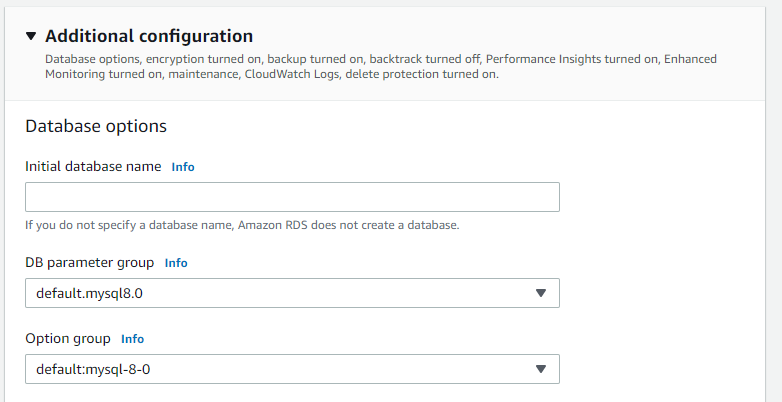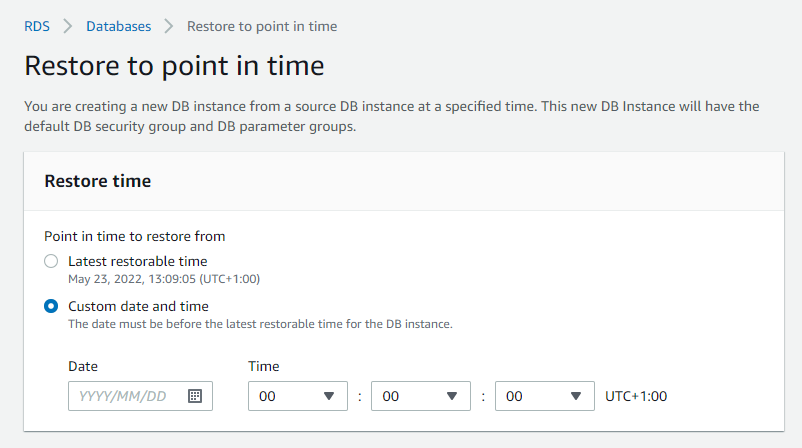RDS
Service Details
AWS managed database (DB) offering. Several different DB types:
| Database Engine | IAM DB Authentication Support |
|---|---|
| Aurora | Yes |
| PostgreSQL | Yes |
| MySQL | Yes |
| MariaDB | No |
| Oracle | No |
| Microsoft SQL Server | No |
The service is backed by EC2 instances.
Single Tenant RDS Instances
If you define a VPC where the instance tenancy is set to dedicated then the RDS instances created within said VPC are on single-tenant hypervisors (details here.)
Operational Notes
- Aurora supports querying the database directly in the console via the "Query Editor". However, this is only supported on Aurora Serverless databases and not provisioned aurora instances.
- Aurora supports provisioned capacity or serverless V1/V2,
- Provisioned or serverless V1 can be upgraded to V2 as outlined here.
- Aurora is fault tolerant by default. In addition, you can create read replica instances which can be promoted to their own independent database at a later date.
- Other database types have the option to select the "multi-az" option which creates another instance in another AZ. This will only become active if the first instance fails - (it's constantly copying and data from the original database).
- If a database is "stopped" it will automatically restart after 7 seven days, there is no way to keep a database permanently stopped in RDS.
- Reserved instances are available for sensitive workloads.
Assessment Notes
- Ensure that the database is being encrypted with KMS - This only applies to encryption at rest.
- In addition, check that snapshots are being encrypted by the service when created.
- If encryption in transit is required database level controls will need to be enforced.
- Ensure the "public access" tick box is not ticked - security groups may prevent it from functioning but in the vast majority of cases it should be disabled.
- Security groups are used to control traffic in and out, restrict with the principal of least privilege.
- Ensure that access to "Query Editor" is appropriately restricted (Aurora only).
IAM Authentication
- RDS for MySQL, PostgreSQL and Aurora can authenticate via IAM roles, consider this when reviewing/creating IAM permissions.
- Master user account is added when the database is created. It should not be used for any application interaction with the database. More details can be found here
- Create database users for workloads and restrict with appropriate database level permission sets.
Networking
- Security groups in use for controlling network access.
- Deployment into subnets (very similar to EC2).
- 2 Subnets required for deployment in a VPC (each must be in a different AZ).
Data Security
- Each Database type comes with a "default parameter group" to control the database options, these should be reviewed and changed as required to follow the principal of least privilege before deployment. More details can be found here
- Option groups also supported to enable optional features of the specific database version.

- Automated database backups available for up to 35 days, with the option to create manual snapshots when needed.
- Aurora can support point in time recovery for the backups it holds, 11/01/2022 14:56:30 for example.

- Full KMS support for data encryption at rest.
Logging
- Fully integrates with CloudWatch for advanced and standard monitoring.
- CloudTrail support for service level monitoring.
Patching and Updates
- Options are available to specify a maintenance window (every Saturday between 01:00/04:00 for example).
- If "Enable auto minor version upgrade" is enabled the database will be automatically patched during the maintenance window.
- Major version upgrades must be performed manually as outlined here
- Using a multi-AZ setup is the best way to avoid disruption as updates are always applied on the standby first, then all connections are moved to the fully upgraded standby instance.
Useful CLI commands
- List all databases in a specific region: \
aws rds describe-db-instances --region eu-west-1 - List all snapshots for a specific DB instance: \
aws rds describe-db-snapshots --region eu-west-1 --db-instance-identifier database-1 - List RDS security groups: \
aws rds describe-db-security-groups